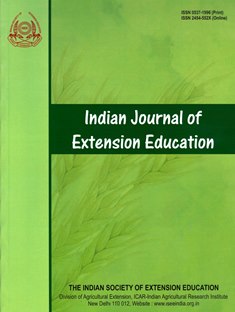Modelling Livelihood Security of Tribal Farmers in South Odisha using Machine Learning
DOI:
https://doi.org/10.48165/IJEE.2025.61423Keywords:
Livelihood security, Tribal farmers, South Odisha, Random Forest, SHAP.Abstract
Tribal farming systems ensure livelihood security through complex socio-economic and behavioural interactions that defy simple linear models. The study analysed primary data collected through simple random sampling method from 180 households in Gajapati and Rayagada districts of Odisha during 2023-24 to analyse the Livelihood Security score using a Random Forest regression. Out-of-bag validation demonstrated model stability with an R² of approximately 0.865 using around 400 trees. The age was the most significant predictor, followed by self-confidence, with smaller contributions from management orientation and innovative proneness. One- and two-dimensional partial dependence outcomes highlighted non-linear age effects and interactions, indicating that increased confidence and enhanced management capacity improve predicted livelihood security across all age groups. These results suggest actionable strategies for agricultural extension: implementing confidence-building and management training tailored to life-stage constraints could yield substantial benefits. Limitations include the correlational nature of the data and the reliance on partial dependence.
Downloads
References
Amghani, M. S., Sabouri, M. S., Baghernejad, J., & Norozi, A. (2025). Factors affecting the livelihood sustainability of smallholder farmers in Iran. Environmental and Sustainability Indicators, 26, 100601. https://doi.org/10.1016/j.indic.2025.100601
Apley, D. W., & Zhu, J. (2020). Visualizing the effects of predictor variables in black box supervised learning models. Journal of the Royal Statistical Society Series B: Statistical Methodology, 82(4), 1059–1086. https://doi.org/10.1111/rssb.12377
Baul, T., Karlan, D., Toyama, K., & Vasilaky, K. (2024). Improving smallholder agriculture via video-based group extension. Journal of Development Economics, 169, 103267. https://doi.org/10.1016/j.jdeveco.2024.103267
Breiman, L. (2001). Random forests. Machine Learning, 45(1), 5–32. https://doi.org/10.1023/A:1010933404324
Das, N., Modak, S., Prusty, A. K., Saha, P., & Suman, S. (2025). Understanding and overcoming key challenges of agripreneurs in Southern Odisha: A case study. Indian Journal of Extension Education, 61(2), 118–122. https://doi.org/10.48165/IJEE.2025.612RN05
Goldstein, A., Kapelner, A., Bleich, J., & Pitkin, E. (2015). Peeking inside the black box: Visualizing statistical learning with plots of individual conditional expectation. Journal of Computational and Graphical Statistics, 24(1), 44–65. https://doi.org/10.1080/10618600.2014.907095
Kerketa, A., Ray, P., Padhy, C., Patra, S. K., Raj, R. K., Mishra, N., & Prasanna, V. (2025). Analysis of adoption practices of SRI in tribal region of Sundargarh district in Odisha. Indian Journal of Extension Education, 61(2), 101–104. https://doi.org/10.48165/IJEE.2025.612RN01
Kumari, A., Deb, A., Prusty, A. K., Suman, S., Rout, D. S., & Amar, A. K. (2024). Preservation of the Indigenous Medicinal Knowledge Network of the Bonda Tribe. Indian Journal of Extension Education, 60(4), 40–46. https://doi.org/10.48165/IJEE.2024.60408
Lekang, B., Nain, M. S., Singh, R., Sharma, J. P., & Singh, D. R. (2017). Factors influencing the utility of experiential learning programme of Indian Council of Agricultural Research. Indian Journal of Agricultural Sciences, 87(3), 325–336.
Lekang, B., Nain, M. S., Singh, R., & Sharma, J. P. (2016). Perceived utility of experiential learning programme of Indian Council of Agricultural Research. Indian Journal of Agricultural Sciences, 86(12), 1536–1546.
Levene, H. (1960). Robust tests for equality of variances. Contributions to Probability and Statistics, 278–292.
Lundberg, S. M., & Lee, S. I. (2017). A unified approach to interpreting model predictions. Advances in Neural Information Processing Systems, 30.
Magakwe, A., Olorunfemi, O., & Sithole, A. (2025). Factors influencing smallholder farmers’ participation in collective marketing: Micro level evidence from Ehlanzeni, South Africa. Frontiers in Sustainable Food Systems, 9, 1567943. https://doi.org/10.3389/fsufs.2025.1567943
Mallick, S., Burman, R. R., Padaria, R. N., Mahra, G. S., Aditya, K., Shekhawat, K., & Mukherjee, S. (2025). Exploring farmers’ psychological perspectives on multimedia-based agro-advisory services. Scientific Reports, 15(1), 8898. https://doi.org/10.1038/s41598-025-92936-3
Pal, P. K., Bhutia, P. T., Das, L., Lepcha, N., & Nain, M. S. (2017). Livelihood diversity in family farming in selected hill areas of West Bengal, India. Journal of Community Mobilization and Sustainable Development, 12(2), 172–178.
Pani, B. S., & Mishra, D. (2022). Sustainable livelihood security in Odisha, India: A district level analysis. Regional Sustainability, 3(2), 110–121. https://doi.org/10.1016/j.regsus.2022.07.003
Panigrahi, S. P., Ghadei, K., Nikhil, J., Chennamadhava, M., Sethi, K., & Gupta, R. P. (2024). Construction and standardisation of agripreneurial performance scale. Indian Journal of Extension Education, 60(3), 88–92. https://doi.org/10.48165/IJEE.2024.603RT01
Prusty, A. K., Saha, P., Das, N., & Suman, S. (2025). Implementation and adoption of smart technologies in agri-allied sectors. Plant Science Today, 11(sp2), 3467. https://doi.org/10.14719/pst.3467
Rana, P., Fischer, H. W., Coleman, E. A., & Fleischman, F. (2024). Using machine learning to uncover synergies between forest restoration and livelihood support in the Himalayas. Ecology and Society, 29(1), 32. https://doi.org/10.5751/ES-14696-290132
Ruzzante, S., Labarta, R., & Bilton, A. (2021). Adoption of agricultural technology in the developing world: A meta-analysis of the empirical literature. World Development, 146, 105599. https://doi.org/10.1016/j.worlddev.2021.105599
Ryo, M. (2022). Explainable artificial intelligence and interpretable machine learning for agricultural data analysis. Artificial Intelligence in Agriculture, 6, 257–265. https://doi.org/10.1016/j.aiia.2022.11.003
Saha, P., Prusty, A. K., Nanda, C., Ray, S., & Sahoo, B. (2024). Professional insights provided by women extension personnel in Odisha. Indian Journal of Extension Education, 60(3), 101–105. https://doi.org/10.48165/IJEE.2024.603RN03
Satapathy, G. P., Das, S., & Tripathy, M. (2024). Factors influencing ICT accessibility among the farming community of Odisha. Indian Journal of Extension Education, 60(2), 38–42. https://doi.org/10.48165/IJEE.2024.60207
Suman, S., Prusty, A. K., Deb, A., Kumari, A., & Reddy, G. S. (2025). Global research trends in family farming: A bibliometric insight. Indian Journal of Extension Education, 61(1), 25–31. https://doi.org/10.48165/IJEE.2025.61105
Zhang, X., Yang, Q., Al Mamun, A., Masukujjaman, M., & Masud, M. M. (2024). Acceptance of new agricultural technology among small rural farmers. Humanities and Social Sciences Communications, 11(1), 1–17. https://doi.org/10.1057/s41599-024-04163-2
Downloads
Published
Issue
Section
License

This work is licensed under a Creative Commons Attribution-NonCommercial-NoDerivatives 4.0 International License.

